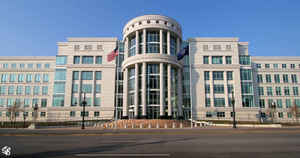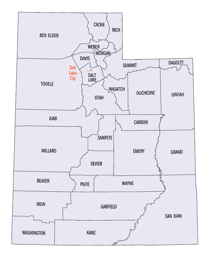Utah Counties
There are twenty-nine counties in the State of Utah. There were originally seven counties established under the provisional State of Deseret in 1849: Davis, Iron, Sanpete, Salt Lake, Tooele, Utah, and Weber. The Territory of Utah was created in 1851 with the first territorial legislature meeting from 1851-1852. The first legislature re-created the original counties from the State of Deseret under territorial law as well as establishing three additional counties: Juab, Millard, and Washington. All other counties were established between 1854 and 1894 by the Utah Territorial Legislature under territorial law except for the last two counties formed, Daggett and Duchesne.Salt Lake County, Utah
Salt Lake County Education, Geography, and History

Salt Lake County is a county located in the state of Utah. Based on the 2010 census, the population was 1,029,655, making it the most
populous county in Utah. Its county seat and largest city is Salt Lake City, the state capital. The county was created in 1850.
Salt Lake County occupies the Salt Lake Valley, as well as parts of the surrounding mountains, the Oquirrh Mountains to the west and the
Wasatch Range to the east (essentially the entire watershed of the Jordan River north of the Traverse Mountains). In addition, the
northwestern section of the county includes part of the Great Salt Lake.
Salt Lake County is part of the Salt Lake City, UT Metropolitan Statistical Area.
Etymology - Origin of Salt Lake County Name
from the Great Salt Lake
Demographics:
County QuickFacts: CensusBureau Quick Facts
Salt Lake County History
The fertile Salt Lake Valley lies
between the Wasatch Mountains on the east and the Oquirrhs on the west. The
active Wasatch Fault runs through the eastern part of the county. The Jordan
River flows north through the valley to Great Salt Lake, and canyon streams
provide culinary and agricultural water and in pioneer times powered mills.
Centuries before settlement prehistoric Indians and the historic Northern
Shoshone and Ute Indians used the area for hunting, fishing, and gathering
seasonal foods. The first white men to see the valley were trappers associated
with William H. Ashley in 1524-25.Permanent settlement began in 1847 with the
arrival of the first Mormon wagon train, which included three women and three
Blacks. The advance company planted the first crops on July 23, and the pioneers
at Brigham Young's direction explored nearby areas, built a fort, and surveyed
Salt Lake City. In October 1847 17-year old Mary Jane Dilworth opened the first
school in her tent.In the next two years a dozen towns were founded in the
county. With self-sufficiency a major goal, the settlers established basic
industries to supply everything from pottery to printing paper and experimented
with mixed success in growing all kinds of plants. In 1862 US troops
established Fort Douglas to protect communications and transportation routes.
Tens of thousands of Mormon immigrants funneled through Salt Lake City to
outlying settlements, and, additionally, for thousands of California-bound
travelers the city was the last major supply point. As the headquarters of the
LDS church, and later the territorial and state capital, Salt Lake City and its
county have always been the center of population, political power, and economic
strength. Political diversity came to the county in 1870 with the founding of
the non-Mormon Liberal party, and until statehood in 1896 the Mormon-Gentile
conflict was intense. Industrial development in the late 19th and early 20th
centuries increased diversity with the arrival of many Greeks, Italians,
Yugoslavs, Blacks, Japanese, and Mexicans. The migration of Native Americans to
the larger cities and the immigration of southeast Asians and others continue
the trend. Hispanics are the largest minority in the county. Although cities and
suburbs now cover much of the land, the county retains traces of its
agricultural beginning as a producer of eggs, hogs, wheat, and garden
vegetables. Mines in Alta and Bingham, smelters in Midvale and Murray, and the
Salt Lake Mining and Stock Exchange made the county a regional mining
hub.Printing and publishing, which began in 1850, continue as major industries.
Other important manufactured goods include pharmaceuticals, candy and other food
products, computers, military guidance systems, and artificial organs. The
county leads in trade, services, transportation, communications, finance,
insurance, and construction. Salt Lake International Airport, major medical
facilities, and television broadcasting serve all of Utah and parts of the
Intermountain region. Government, including education, is the leading employer
in the county. The founding of the University of Deseret (Utah) in 1850 and the
dedication of the Salt Lake Theatre in 1862 provide two examples of the early
commitment of residents to education and culture. The county is home to several
public and private colleges and dozens of theatrical, musical, and dance
organizations.
*Sources: Beehive History 14:
Utah Counties. 1988. Utah State Historical Society, 300 Rio Grande, Salt Lake
City, UT 84101-1182.
Geography: Land and Water
As reported by the Census Bureau, the county has a total area of 808 square miles (2,092 km2), of which, 737
square miles (1,910 km2) of it is land and 70 square miles (182 km2) of it (8.72%) is water.
Perhaps the most dominating physical feature in Salt Lake County are the Wasatch Mountains in the eastern portion of
the county, famous for both summer and winter activities. The snow in the region is often coined the "Greatest Snow
on Earth" for its soft, powdery texture, and led to Salt Lake City winning the bid for the 2002 Winter Olympics. In
Salt Lake County there are four ski resorts; Snowbird and Alta in Little Cottonwood Canyon and Solitude and Brighton
in Big Cottonwood Canyon. Hiking and camping are especially popular summer activities. Marking the western portion
of the county are the Oquirrh Mountains. These two mountain ranges together, along with the much smaller Traverse
Mountains to the south of the valley, delimit Salt Lake Valley, which is also flanked on the northwest by the Great
Salt Lake.
All of the entrances to the valley are narrow. These include Parley's Canyon leading into Summit County to the
northeast, Emigration Canyon leading into Morgan County, also to the northeast, the space between the Wasatch
Mountains and the Great Salt Lake leading into Davis County to the north, the "Point of the Mountain" leading to
Utah County to the south, and a space between the Oqiurrh Mountains and the Great Salt Lake leading to Tooele County
to the northwest. On the north and east benches, the houses sometimes climb as far as halfway up the mountain, and
new communities are also being constructed on the steeper southern and western slopes. Rapid residential
construction continues in the west-central, southwest, and southern portions of the valley. In the far west,
southwest, and northwest, rural areas still exist, but rapid growth threatens what remains of the natural
environment in the valley.
Salt Lake County borders Davis County to the north, Morgan County to the northeast, Summit County to the east,
Tooele County to the west, Wasatch County to the southeast, and Utah County to the south.
Neighboring Counties
Bordering counties are as follows:
- Davis County, UT to the north
- Morgan County, UT to the northeast
- Summit County, UT to the east
- Tooele County, UT to the west
- Utah County, UT to the south
- Wasatch County, UT to the southeast
Education
The county has one major research university, the University of Utah. Westminster College and Salt Lake Community College also have large, well defined campuses in the county. Colleges with smaller, non-traditional campuses in the county include Roseman University of Health Sciences, Broadview University, Eagle Gate College, LDS Business College, Newmont University, and Stevens-Henager College.







